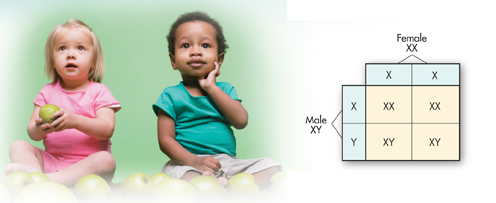The karyotype in Figure 14–1 is from a typical human cell, which contains 46 chromosomes, arranged in 23 pairs. Why do our chromosomes come in pairs? Remember that we begin life when a haploid sperm, carrying just 23 chromosomes, fertilizes a haploid egg, also with 23 chromosomes. The resulting diploid cell develops into a new individual and carries the full complement of 46 chromosomes—two sets of 23.
Sex Chromosomes Two of the 46 chromosomes in the human genome are known as sex chromosomes, because they determine an individual's sex. Females have two copies of the X chromosome. Males have one X chromosome and one Y chromosome. As you can see in Figure 14–2, this is the reason why males and females are born in a roughly 50 : 50 ratio. All human egg cells carry a single X chromosome (23, X). However, half of all sperm cells carry an X chromosome (23, X) and half carry a Y chromosome (23, Y). This ensures that just about half the zygotes will be males and half will be females.

FIGURE 14–2 Sex Ratios Human egg cells contain a single X chromosome. Sperm cells contain either one X chromosome or one Y chromosome. Interpret Tables What does this Punnett square suggest about the sex ratio of the human population?
ddMore than 1200 genes are found on the X chromosome, some of which are shown in Figure 14–3. Note that the human Y chromosome is much smaller than the X chromosome and contains only about 140 genes, most of which are associated with male sex determination and sperm development.
Autosomal Chromosomes To distinguish them from the sex chromosomes, the remaining 44 human chromosomes are known as autosomal chromosomes, or autosomes. The complete human genome consists of 46 chromosomes, including 44 autosomes and 2 sex chromosomes. To quickly summarize the total number of chromosomes present in a human cell—both autosomes and sex chromosomes—biologists write 46, XX for females and 46, XY for males.
 In Your Notebook Describe what makes up a human karyotype.
In Your Notebook Describe what makes up a human karyotype.

FIGURE 14–3 X and Y Chromosomes The human Y chromosome is smaller and carries fewer genes than the human X chromosome.
dTable of Contents
- Formulas and Equations
- Applying Formulas and Equations
- Mean, Median, and Mode
- Estimation
- Using Measurements in Calculations
- Effects of Measurement Errors
- Accuracy
- Precision
- Comparing Accuracy and Precision
- Significant Figures
- Calculating With Significant Figures
- Scientific Notation
- Calculating With Scientific Notation
- Dimensional Analysis
- Applying Dimensional Analysis




